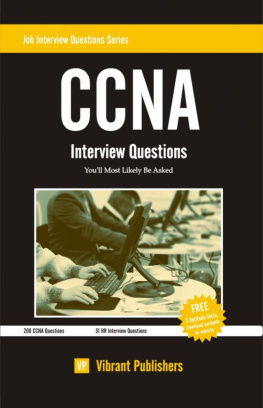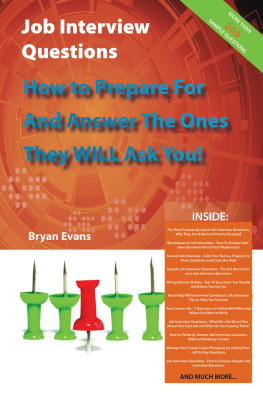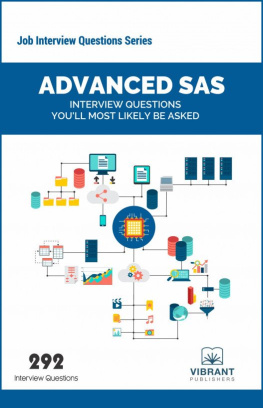CCNA
Interview Questions You'll Most Likely Be Asked Job Interview Questions Series www.vibrantpublishers.com ***** CCNA Interview Questions You'll Most LikelyBe Asked Published by Vibrant Publishers atSmashwords Copyright 2013 Vibrant Publishers, USA. Smashwords Edition, License Notes This ebook is licensed for your personal useonly. This ebook may not be re-sold or given away to other people.If you would like to share this book with another person, pleasepurchase an additional copy for each recipient. If youre readingthis book and did not purchase it, or it was not purchased for youruse only, then please return to Smashwords.com and purchase yourown copy. Thank you for respecting the hard work of thisauthor. This publication is designed to provideaccurate and authoritative information in regard to the subjectmatter covered.
The author has made every effort in the preparationof this book to ensure the accuracy of the information. However,information in this book is sold without warranty either expressedor implied. The Author or the Publisher will not be liable for anydamages caused or alleged to be caused either directly orindirectly by this book. Vibrant Publishers books are available atspecial quantity discount for sales promotions, or for use incorporate training programs. For more information please write tobulkorders@vibrantpublishers.com Please email feedback / corrections(technical, grammatical or spelling) tospellerrors@vibrantpublishers.com To access the complete catalogue of VibrantPublishers, visit www.vibrantpublishers.com ***** Table of Contents *****
CCNA Interview Questions
Review these typical interview questions andthink about how you would answer them. ***** 1: What is OSI reference model networklayer? Answer: Network layer is layer 3 of the OSI referencemodel that defines logical addressing, routing and pathdetermination. ***** 1: What is OSI reference model networklayer? Answer: Network layer is layer 3 of the OSI referencemodel that defines logical addressing, routing and pathdetermination.
Examples of the protocols working at this layer areIP and IPX. 2: Which of the below are Transport layerprotocols? a) TCP b) HTTP c) IP d) UDP Answer: a. TCP, d. HTTP 3: In networking terminology, what is dataencapsulation? Answer: Data encapsulation is the process of puttingheaders and trailers around the data. Each layer encapsulates theupper layers data into a new header and trailer. 4: In which OSI reference model layer doesHTTP operate? a) Transport layer b) Network layer c) Application layer d) Physical layer Answer c. 4: In which OSI reference model layer doesHTTP operate? a) Transport layer b) Network layer c) Application layer d) Physical layer Answer c.
Application layer 5: What is CSMA/CD and how does it work? Answer: When the data i transmitted by two or threenodes on a network through the cable, there occurs collision. So,CSMA/CA(Carrier Sense Multiple Access/ Collision Avoidance) isused, Before transmitting the data on the cable,NIC(network Interface Card) checks the cable if any transmission isgoing on. If no, sends the data or waits for the transmission tofinish. If two NIC senses the medium at the sametime, and send the data there occurs collision. Then the nodedetects the collision and sends a Jam Signal to all other nodeson that network. 6: What are the two kinds of transportpossible and give some example? Answer: a) Reliable and unreliable are the two kindsof transport possible b) The transport varies according to theapplication c) The reliable protocol is defined byTCP d) The unreliable protocol is defined byUDP Example UDP is used in SNMP TCP is used in HTTP 7: How TCP ensures a reliable as well ascontrolled transport? Answer: a) The reliable transport is ensured by theassurance of data delivery b) The controlled transport is ensured bycongestion control which means when the resources are busy it doesnot send the data 8: For an inherent requirement applicationwhich protocol would be better to use at the transport layer? Answer: TCP protocol would be better to use becauseit resend the acknowledgement when the packet is not received 9: When the client will declare that theserver is unreachable if the client sends data to aserver? Answer: a) Even though the server does not send anacknowledgement, the client will not declare the server that it isunreachable.
Instead, it resends the data packet until it reachesits threshold value. Declares that the server is unreachable b) If the client does not receive anyacknowledgment after reaching its threshold value, then itdeclares that the server is unreachable 10: Why the windowing concept is introducedin TCP? Answer: In TCP, an acknowledgement is sent every timewhen a fragment of data is received. This increases the trafficwhen a large amount of data is sent. To avoid this, thewindowing concept is introduced. 11: List the TCP/IP port for following: a) FTP b) TELNET c) HTTP d) SNMP e) POP3 Answer: FTP-21 TELNET-23 HTTP-80 SNMP-25 POP3-110 12: What are the advantages of UDP overTCP? Answer: a) Both are transport layer protocols.UDP isa connectionless protocol while TCP is a connection orientedprotocol b) UDP provides low overhead data deliverythan TCP c) UDP find applications in the Domain NameSystem (DNS) , Video Streaming , Voice over IP (VoIP) whereas TCPhas applications in Web Browsers , E-mail , File Transfers ***** 13: Which connector type is used in Ethernetcables? a) RJ11 b) RJ12 c) RJ55 d) RJ45 Answer: d. RJ45 14: What is broadcast MAC address and whatis its value? Answer: The broadcast MAC address is a type of layer2 address that is used to deliver data to all devices in the samebroadcast domain of the sender.
The source sends only one frame onthe network and the switch replicates it to all ports in the samebroadcast domain of the source. The broadcast MAC address has avalue of FFFF.FFFF.FFFF. 15: Describe twisted pair cables andmention why they are twisted. Answer: Ethernet cables contain 8 wires in 4 pairsgroups. Each pair is twisted so that the magnetic field created byone wire cancels out the magnetic field created by the other wire.This enhances performance and decreases transmission noise. 16: Describe how you can make an Ethernetcross-over cable.
Answer: Ethernet cross-over cable is created byconnecting Pins 1 and 2 on one side of the cable to pins 3 and 6 onthe other side. The other pins connectivity doesnt matter as thenetwork device uses only 4 wires of the 8 to send and receivedata. 17: What typical cable type do you use toconnect two switches together? a) Straight-through cable b) Roll-over cable c) Console cable d) Cross-over cable Answer: d. Cross-over cable 18: What is the maximum cable length in FastEthernet (IEEE 802.3u) standard? a) 100m b) 200m c) 50m d) 500m Answer: a. 100m ***** 19: What is the speed of E1 line? a) 64 kbps b) 1.544 Mbps c) 2.048 Mbps d) 1.026 Mbps Answer: c. HDLC, b. PPP, c. PPP, c.
Frame-relay 21: Which of the below are types of DigitalSubscriber line (DSL)? a) ADSL b) HDSL c) VDSL d) NDSL Answer: a. ADSL, b. HDSL, c. VDSL 22: What is ATM? Answer: ATM (asynchronous transfer mode) is adedicated-connection switching technology used for WAN links. ATMorganizes digital data into cell units and transmits them over aphysical medium using digital signal technology. ADS, b. ADS, b.
Cable Modems, d. HDSL 24: You use a DSL connection at home forinternet connectivity. You use an IP address of 10.10.10.10 on yourPC. The DSL is doing NAT for your IP to 41.111.23.23 to accessinternet. According to NAT terminology, what is the name of your IPaddress after being NATed to the public IP as viewed oninternet? a) Inside local b) Inside global c) Outside local d) Outside global Answer: b. PPP, c. PPP, c.
HDLC 26: Which command below do you use toconfigure PPP on a serial interface? a) use ppp b) set ppp c) encapsulation ppp d) protocol ppp Answer: c. encapsulation ppp 27: When configuring Internet Access Routerin small office, which features below are usually configured toallow internet access for users? a) PAT b) BGP c) DHCP d) Telnet Answer a. PAT, c. DHCP 28: Why PAT is used when configuring SOHOrouters? Answer: PAT (Port Address Translation) is a NAT typein which each computer on LAN is translated to the same IP address,but with a different port number assignment. Small Office/HomeOffice (SOHO) routers are used in small offices to connect users tointernet. It uses one Public IP address for internet access.















